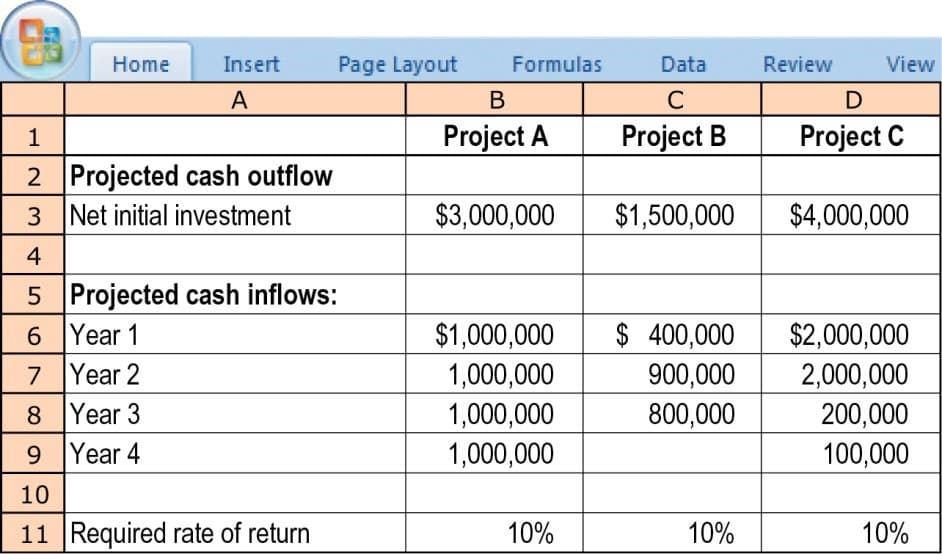What are the benefits and limitations of using the payback method to choose between projects? Calculate the payback period for each of the three projects. Ignore income taxes. Using the payback method, which projects should Andrews choose? Bart thinks that projects should be selected based on their NPVs. Assume all cash flows occur at the end of the year except for initial investment amounts. Calculate the NPV for each project. Ignore income taxes. 3. Which projects, if any, would you recommend funding? Briefly explain why
What are the benefits and limitations of using the payback method to choose between projects? Calculate the payback period for each of the three projects. Ignore income taxes. Using the payback method, which projects should Andrews choose? Bart thinks that projects should be selected based on their NPVs. Assume all cash flows occur at the end of the year except for initial investment amounts. Calculate the NPV for each project. Ignore income taxes. 3. Which projects, if any, would you recommend funding? Briefly explain why
Essentials Of Investments
11th Edition
ISBN:9781260013924
Author:Bodie, Zvi, Kane, Alex, MARCUS, Alan J.
Publisher:Bodie, Zvi, Kane, Alex, MARCUS, Alan J.
Chapter1: Investments: Background And Issues
Section: Chapter Questions
Problem 1PS
Related questions
Question
100%
Because the company’s cash is limited, Andrews thinks the payback method should be used to choose between the capital budgeting projects.
- What are the benefits and limitations of using the payback method to choose between projects?
- Calculate the payback period for each of the three projects. Ignore income taxes. Using the payback method, which projects should Andrews choose?
- Bart thinks that projects should be selected based on their NPVs. Assume all cash flows occur at the end of the year except for initial investment amounts. Calculate the
NPV for each project. Ignore income taxes.
3. Which projects, if any, would you recommend funding? Briefly explain why

Transcribed Image Text:Home
Insert
Page Layout
Formulas
Data
Review
View
A
В
C
D
Project A
Project B
Project C
2 Projected cash outflow
3 Net initial investment
$3,000,000
$1,500,000
$4,000,000
4
5 Projected cash inflows:
6 Year 1
7 Year 2
$ 400,000
$1,000,000
1,000,000
$2,000,000
2,000,000
200,000
900,000
8 Year 3
800,000
1,000,000
1,000,000
9 Year 4
100,000
10
11 Required rate of return
10%
10%
10%
Expert Solution
This question has been solved!
Explore an expertly crafted, step-by-step solution for a thorough understanding of key concepts.
This is a popular solution!
Trending now
This is a popular solution!
Step by step
Solved in 4 steps with 2 images

Knowledge Booster
Learn more about
Need a deep-dive on the concept behind this application? Look no further. Learn more about this topic, finance and related others by exploring similar questions and additional content below.Recommended textbooks for you

Essentials Of Investments
Finance
ISBN:
9781260013924
Author:
Bodie, Zvi, Kane, Alex, MARCUS, Alan J.
Publisher:
Mcgraw-hill Education,



Essentials Of Investments
Finance
ISBN:
9781260013924
Author:
Bodie, Zvi, Kane, Alex, MARCUS, Alan J.
Publisher:
Mcgraw-hill Education,



Foundations Of Finance
Finance
ISBN:
9780134897264
Author:
KEOWN, Arthur J., Martin, John D., PETTY, J. William
Publisher:
Pearson,

Fundamentals of Financial Management (MindTap Cou…
Finance
ISBN:
9781337395250
Author:
Eugene F. Brigham, Joel F. Houston
Publisher:
Cengage Learning

Corporate Finance (The Mcgraw-hill/Irwin Series i…
Finance
ISBN:
9780077861759
Author:
Stephen A. Ross Franco Modigliani Professor of Financial Economics Professor, Randolph W Westerfield Robert R. Dockson Deans Chair in Bus. Admin., Jeffrey Jaffe, Bradford D Jordan Professor
Publisher:
McGraw-Hill Education